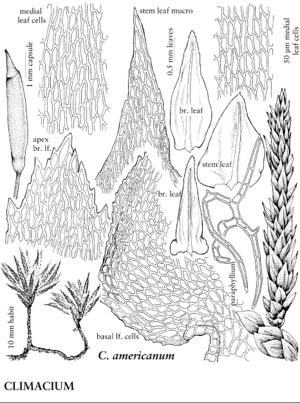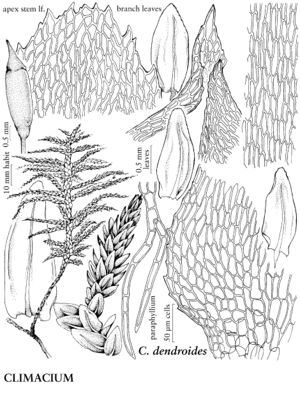Plants large, in loose or dense tufts. Stems creeping, sympodial, stipe erect, secondary stems erect, usually dendroid, 1 (or 2)-pinnate, branches terete-foliate, attenuate-caudate distally; hyalodermis absent, sclerodermis of 1 or 2 rows of cells, central strand present; paraphyllia many, hyaline, 1-seriate; loosely tomentose, rhizoids red. Primary stem leaves appressed, scalelike. Distal stem and branch leaves oblong-ovate to ovate-lanceolate; base narrowly decurrent; margins entire to serrulate proximally, toothed distally; apex acute to obtuse and apiculate; costa single, subpercurrent, smooth; alar cells subquadrate; laminal cells 1-stratose, smooth; proximal cells oblong-rhombic to linear-rhomboidal; medial cells linear-elongate, rhomboidal to subquadrate; apical cells rectangular to rounded-fusiform, walls thin or slightly thickened. Specialized asexual reproduction absent. Sexual condition dioicous; inflorescences on secondary stems and bases of branches. Seta single, elongate, straight, smooth. Capsule erect, symmetric; differentiated annulus absent; operculum conic-acute to subrostrate; peristome double; exostome teeth 16, connate at base, dark red-brown, linear-lanceolate, somewhat trabeculate, external surface minutely and densely papillose, bordered, minutely and irregularly perforate; endostome golden brown, basal membrane low, segments well developed, linear, as long as teeth, keeled, minutely and densely papillose, split along median line or gaping, ultimately split to apex, cilia absent or rudimentary. Calyptra cucullate, smooth, reaching capsule base. Spores (12–)15–22 µm, minutely papillose, yellowish brown.
Distribution
North America, Mexico (Veracruz), Eurasia, Atlantic Islands, Pacific Islands (New Zealand), Australia.
Discussion
Genus 1, species 3 (2 in the flora).
Climaciaceae are characterized by dendroid branching from a primary rhizomelike subterranean stem, erect capsules, and abundant filiform paraphyllia that are intermediate in morphology between rhizoids and paraphyllia. The longitudinal cauline lamellae on the stipe of Pleuroziopsaceae (monospecific, Pleuroziopsis) (R. R. Ireland 1968) has been used to separate that family, but stem lamellae can be found in Climacium as well (D. H. Norris and M. S. Ignatov 2000). The absence of filiform paraphyllia, strongly decurrent leaves with inflated alar cells, and cernuous, asymmetric capsules of the genus Pleuroziopsis separate the two families.
A. L. Andrews (1954) found rhizoidlike paraphyllia in both Climaciaceae and Hylocomiaceae; H. A. Crum and L. E. Anderson (1981) agreed. The rhizoids in Climacium are red, minutely roughened, with oblique cross walls. The paraphyllia are often mixed with the rhizoids, and are hyaline to tinged with red, smooth, with perpendicular cross walls. According to D. H. Norris and M. S. Ignatov (2000), however, the paraphyllia of Climacium are actually rhizoids, and there is intergradation of morphology. The red-brown exostome in Climacium is incurved when dry in contrast to the erect, yellow-brown segments of the endostome.

